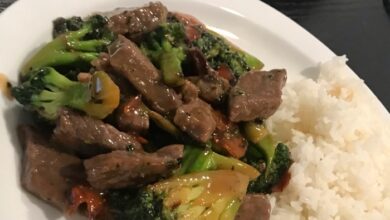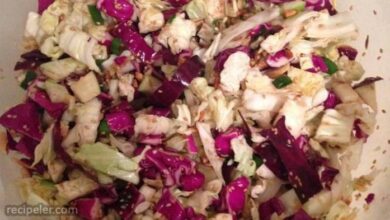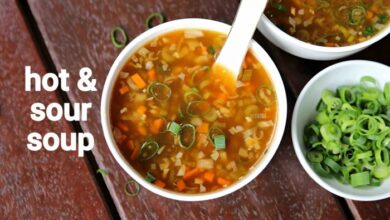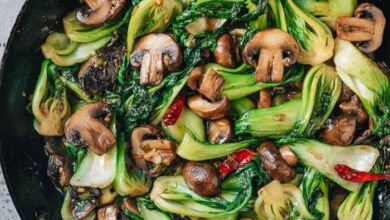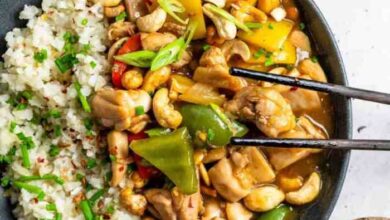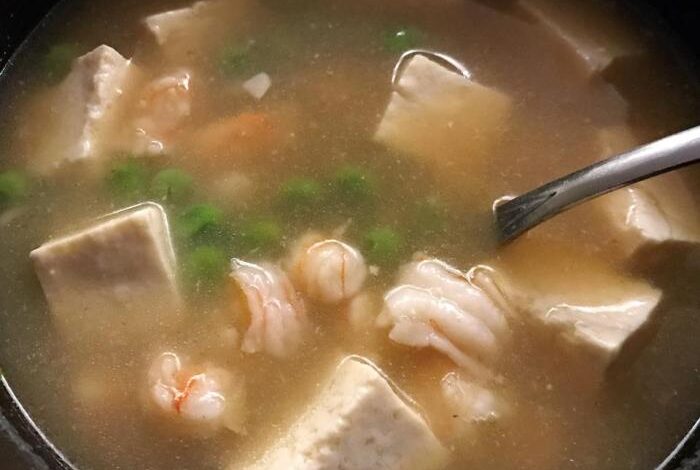
Chinese Shrimp and Tofu Soup: A Culinary Journey
Chinese shrimp and tofu soup, a harmonious blend of flavors and textures, takes us on a culinary journey through the heart of Chinese cuisine. This comforting soup, with its delicate broth, succulent shrimp, and silken tofu, embodies the essence of balance and harmony that defines Chinese culinary traditions.
From its historical origins and regional variations to its nutritional benefits and cultural significance, Chinese shrimp and tofu soup offers a glimpse into the rich tapestry of Chinese food culture. Its simplicity and versatility make it a staple in countless homes and a cherished dish served at special occasions.
History and Origins
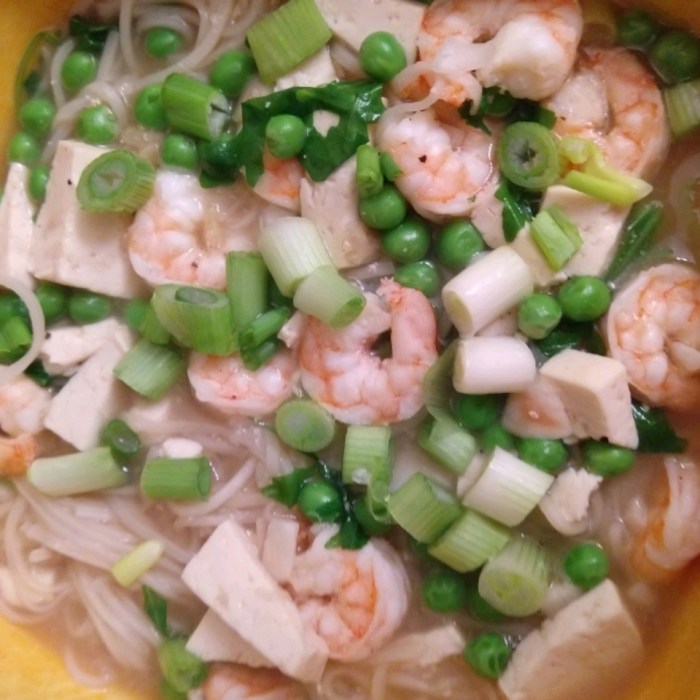
Chinese shrimp and tofu soup, a beloved dish across the country, has a rich history rooted in both culinary tradition and practicality. Its origins can be traced back centuries, with variations appearing across different regions, reflecting local ingredients and cooking styles.
Regional Variations
The variations of this soup reflect the diverse culinary landscape of China. Here are some prominent regional examples:
- Northern China:In the north, the soup often features a clear broth, with the addition of vegetables like cabbage, mushrooms, and sometimes a touch of vinegar.
- Southern China:The southern version tends to be richer, incorporating ingredients like pork bones, ginger, and a variety of seafood, including shrimp, crab, and fish.
- Sichuan Province:The Sichuan region, known for its spicy cuisine, adds chili peppers and Sichuan peppercorns to the soup, creating a fiery and flavorful experience.
Evolution Over Time
The evolution of Chinese shrimp and tofu soup has been influenced by various factors, including:
- Ingredient Availability:Over time, the availability of ingredients has changed, leading to adaptations in the soup’s recipe. For instance, the use of tofu, a versatile and affordable protein source, became more common in the 16th century, making it a staple ingredient in many soups.
- Cultural Exchange:Trade and cultural exchange between different regions have also played a role in the soup’s evolution. The introduction of new ingredients and cooking techniques from other countries has influenced the way the soup is prepared and served.
- Modern Innovations:In recent decades, chefs have experimented with new flavor combinations and techniques, creating modern variations of the classic shrimp and tofu soup.
Nutritional Value
Chinese shrimp and tofu soup is not just a delicious and comforting meal, it’s also a nutritional powerhouse. Packed with protein, vitamins, and minerals, this soup offers a range of health benefits.
Chinese shrimp and tofu soup is a light and flavorful dish that’s perfect for a warm evening. It’s also a great way to use up leftover shrimp. If you’re looking for a refreshing cocktail to pair with it, I highly recommend a raspberry lemon drop martini.
The tartness of the lemon and the sweetness of the raspberry will complement the delicate flavors of the soup perfectly.
Nutritional Content
This soup is a rich source of essential nutrients, including:
- Protein:Both shrimp and tofu are excellent sources of protein, which is crucial for building and repairing tissues, producing enzymes and hormones, and maintaining a healthy immune system.
- Vitamins:The soup is rich in vitamins B12, D, and E. Vitamin B12 is essential for red blood cell production, while vitamin D helps the body absorb calcium and phosphorus. Vitamin E is an antioxidant that protects cells from damage.
- Minerals:Shrimp and tofu provide minerals like calcium, iron, zinc, and magnesium. Calcium is vital for strong bones and teeth, iron supports red blood cell production, zinc plays a role in immune function and wound healing, and magnesium helps regulate blood pressure and muscle function.
- Omega-3 Fatty Acids:Shrimp is a good source of omega-3 fatty acids, which are known to improve heart health, reduce inflammation, and support brain function.
Comparison with Other Chinese Dishes
Compared to other popular Chinese dishes, shrimp and tofu soup stands out for its lower calorie content and higher protein content. For instance, a serving of fried rice or stir-fried noodles can contain significantly more calories and fat, while providing less protein.
Chinese shrimp and tofu soup is a light and flavorful dish that’s perfect for a weeknight meal. The broth is infused with ginger and garlic, and the shrimp and tofu add a nice protein boost. For a heartier meal, you could try adding some vegetables like spinach or bok choy.
If you’re looking for a more comforting and filling option, I recommend checking out this recipe for slow cooker corned beef and cabbage. It’s a classic dish that’s perfect for a cold winter day. Once you’ve had your fill of hearty comfort food, you can always come back to the light and refreshing Chinese shrimp and tofu soup!
Potential Health Benefits
Regular consumption of Chinese shrimp and tofu soup can offer several health benefits:
- Improved Heart Health:The omega-3 fatty acids in shrimp and the low saturated fat content of tofu contribute to heart health by lowering cholesterol levels and reducing the risk of heart disease.
- Stronger Bones:The calcium in tofu and shrimp helps maintain bone density, reducing the risk of osteoporosis.
- Boosted Immunity:The protein, zinc, and vitamin E in the soup support the immune system, helping the body fight off infections and diseases.
- Weight Management:The soup’s low calorie content and high protein content can aid in weight management by promoting satiety and reducing cravings.
Cultural Significance
Chinese shrimp and tofu soup, known as “虾仁豆腐汤” (xiā rén dòu fu tāng) in Mandarin, holds a significant place in Chinese culinary tradition, reflecting the deep connection between food and culture in China. This nourishing soup is not just a dish but a symbol of balance, harmony, and auspiciousness, reflecting the core values of Chinese culture.
Role in Traditional Chinese Meals and Celebrations
Shrimp and tofu soup often features as a staple in traditional Chinese meals, particularly during family gatherings and special occasions. Its presence signifies a celebration of togetherness and good fortune.
- Family Dinners:This soup is a common sight on dinner tables across China, offering a light and flavorful addition to a meal. It is often served alongside other dishes, creating a balanced and satisfying culinary experience.
- Weddings and Birthdays:In Chinese culture, weddings and birthdays are significant events filled with symbolism. Shrimp and tofu soup is often served at these celebrations, representing prosperity and longevity. The shrimp, known for its fast movement, symbolizes good fortune and progress, while tofu, with its soft and smooth texture, represents peace and harmony.
- Lunar New Year:During the Lunar New Year, a time for family reunions and festivities, this soup is often prepared, symbolizing a fresh start and good luck for the year ahead. It is often served with other auspicious dishes like dumplings and fish, creating a feast that reflects the joyful spirit of the occasion.
Cultural Traditions Associated with the Soup, Chinese shrimp and tofu soup
Beyond its role in meals and celebrations, Chinese shrimp and tofu soup is also associated with various cultural traditions.
- Nourishing the Body and Mind:This soup is considered to be a nourishing and healthy dish, particularly for those who are recovering from illness or seeking to maintain their well-being. Its ingredients are believed to possess medicinal properties, promoting health and vitality. For example, shrimp is rich in protein and calcium, while tofu is a good source of plant-based protein and antioxidants.
- Symbolism of Harmony and Balance:The combination of shrimp and tofu in this soup represents the balance between yin and yang, two opposing forces that are essential for harmony in Chinese philosophy. Shrimp, considered yang (masculine and active), complements tofu, considered yin (feminine and passive), creating a harmonious and balanced dish.
Variations and Adaptations: Chinese Shrimp And Tofu Soup
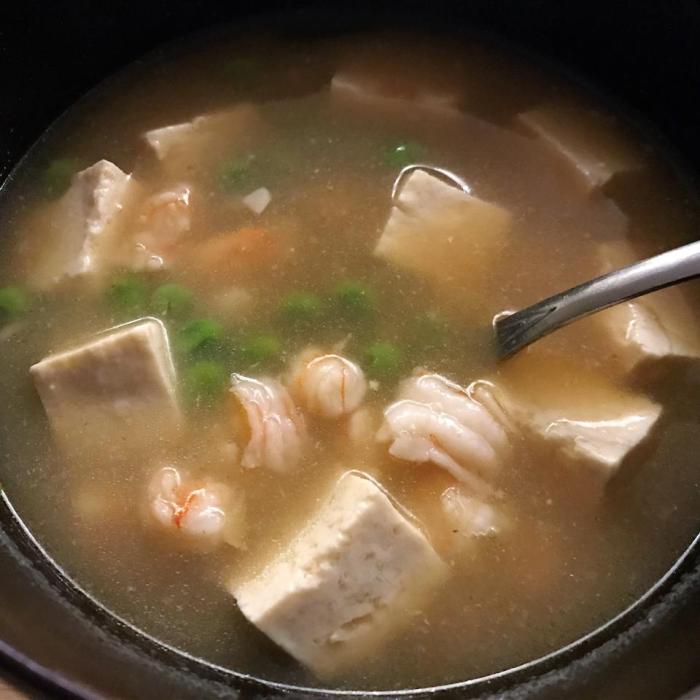
The beauty of Chinese shrimp and tofu soup lies in its adaptability. This simple dish can be customized to suit different tastes and dietary needs, offering a wide range of variations.
Regional Variations
The most common variations of Chinese shrimp and tofu soup are found across different regions of China. These variations often reflect the local culinary traditions and readily available ingredients.
- Shanghai-style:This version typically features a richer broth made with pork bones and a generous amount of ginger. It also often includes a variety of vegetables, such as Napa cabbage, mushrooms, and bamboo shoots.
- Sichuan-style:This variation is known for its spicy and flavorful broth. It often incorporates chili peppers, Sichuan peppercorns, and fermented black beans, adding a distinct aroma and heat to the soup.
- Cantonese-style:This version often features a lighter broth and a wider variety of seafood, such as clams, scallops, and fish. It may also include ingredients like dried shrimp, preserved vegetables, and fresh herbs.
Dietary Adaptations
This soup can be easily adapted to accommodate different dietary needs and preferences.
- Vegetarian:Simply omit the shrimp and use a vegetable broth base. You can also add additional vegetables like spinach, bok choy, or tofu skin for extra protein and flavor.
- Vegan:Use a plant-based broth and ensure all ingredients are vegan-friendly. You can also add a tablespoon of soy sauce or tamari for extra umami flavor.
- Low-Sodium:Use a low-sodium broth and reduce the amount of salt added. You can also substitute soy sauce with a low-sodium alternative.
- Gluten-Free:Ensure all ingredients, including the broth and soy sauce, are gluten-free. Look for gluten-free soy sauce or tamari.

